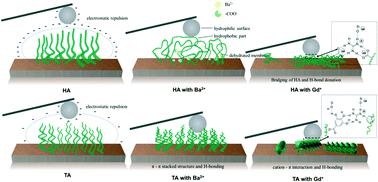当前位置:
X-MOL 学术
›
Environ. Sci.: Nano
›
论文详情
Our official English website, www.x-mol.net, welcomes your
feedback! (Note: you will need to create a separate account there.)
Role of NOM–hematite nanoparticle complexes and organic and inorganic cations in the coherence of silica and clay particles: evaluation based on nanoscale forces and molecular self-assembly
Environmental Science: Nano ( IF 5.8 ) Pub Date : 2021-2-19 , DOI: 10.1039/d0en01182g Zhenquan Wang 1, 2, 3 , Bo Feng 3, 4, 5, 6, 7 , Di Zhang 1, 2, 3 , Saikat Ghosh 1, 2, 3 , Bo Pan 1, 2, 3 , Baoshan Xing 8, 9, 10, 11
Environmental Science: Nano ( IF 5.8 ) Pub Date : 2021-2-19 , DOI: 10.1039/d0en01182g Zhenquan Wang 1, 2, 3 , Bo Feng 3, 4, 5, 6, 7 , Di Zhang 1, 2, 3 , Saikat Ghosh 1, 2, 3 , Bo Pan 1, 2, 3 , Baoshan Xing 8, 9, 10, 11
Affiliation

|
The evaluation of the nanoscale forces between a silica probe and hematite nanoparticle (NP) thin layer-coated mica (Hm-mica) in the presence of structurally different natural organic matter (NOM) molecules and inorganic and organic guanidinium (Gd+) cations determines the efficiency of cementing agents towards stable soil aggregate formation. The force–distance curves showed that electrostatic repulsions between the probe and the 5 and 50 mg C per L humic acid (HA)-modified Hm-mica substrates were initiated at higher probe–substrate separations relative to tannic acid (TA)-modified Hm-mica substrates. The abundance of highly ionizable polar carboxylate moieties in HA compared to TA contributed to stronger probe–substrate repulsion. The ion-specific interactions of the weakly hydrated divalent cations with the adsorbed HA diminished the probe–substrate electrostatic repulsion. However, possible exposure of hydrophobic domains contributed to weak adhesion with the silica probe. The maximum adhesion of 0.11 ± 0.04 mN m−1 was recorded in 5 mg C per L HA-modified Hm-mica in the presence of Ca2+. Nevertheless, 50 mg C per L TA modified Hm-mica exhibited a significant increase in adhesion to 1.44 ± 0.5 mN m−1 in the presence of Ba2+. The porous nanostructures produced due to Ba2+-assisted molecular gelation of TA possibly contributed to the strong adhesion. Unlike inorganic cations, organic Gd+ has increased probe–substrate adhesion considerably to 3.13 ± 0.29 mN m−1 in 50 mg C per L HA-modified Hm-mica. The porous nanotubular structures produced by HA in the presence of Gd+ possibly maintained the interfacial water content and facilitated adhesion with the silica probe. Thermodynamic parameters derived from the reactions between the NOM and the cations further supplemented the force data. Therefore, interactions of sesquioxide nanominerals with soil biodegradation products can improve the environmental quality and mitigate the effects of destabilizing forces.
中文翻译:

NOM-赤铁矿纳米颗粒复合物以及有机和无机阳离子在二氧化硅和粘土颗粒的粘合中的作用:基于纳米力和分子自组装的评估
在结构上不同的天然有机物(NOM)分子以及无机和有机胍(Gd +阳离子决定了胶结剂对稳定土壤团聚体形成的效率。力-距离曲线显示,探针与5 L和50 mg C / L腐殖酸(HA)修饰的Hm-云母底物之间的静电排斥是在相对于单宁酸(TA)修饰的Hm更高的探针-底物分离度下开始的-云母基材。与TA相比,HA中高度可离子化的极性羧酸根部分丰富,有助于增强探针-底物的排斥力。弱水合的二价阳离子与吸附的HA的离子特异性相互作用减少了探针-底物的静电排斥。但是,可能会暴露疏水域,从而导致与硅胶探针的附着力弱。最大附着力0.11±0.04 mN m -1在Ca 2+存在下,每L HA修饰的Hm云母以5 mg C记录碳原子。然而,在存在Ba 2+的情况下,每L TA改性的Hm云母50 mg C的粘附力显着增加至1.44±0.5 mN m -1。由于Ba 2+辅助的TA分子胶凝作用而产生的多孔纳米结构可能有助于强粘附性。与无机阳离子不同,在每L HA修饰的Hm云母中,有机Gd +在50 mg C中的探针-底物附着力显着提高至3.13±0.29 mN m -1。HA在Gd +存在下产生的多孔纳米管结构可能会保持界面水含量,并促进与硅胶探针的粘合。由NOM和阳离子之间的反应得出的热力学参数进一步补充了力数据。因此,倍半氧化物纳米矿物质与土壤生物降解产物的相互作用可以改善环境质量并减轻破坏力的影响。
更新日期:2021-03-02
中文翻译:

NOM-赤铁矿纳米颗粒复合物以及有机和无机阳离子在二氧化硅和粘土颗粒的粘合中的作用:基于纳米力和分子自组装的评估
在结构上不同的天然有机物(NOM)分子以及无机和有机胍(Gd +阳离子决定了胶结剂对稳定土壤团聚体形成的效率。力-距离曲线显示,探针与5 L和50 mg C / L腐殖酸(HA)修饰的Hm-云母底物之间的静电排斥是在相对于单宁酸(TA)修饰的Hm更高的探针-底物分离度下开始的-云母基材。与TA相比,HA中高度可离子化的极性羧酸根部分丰富,有助于增强探针-底物的排斥力。弱水合的二价阳离子与吸附的HA的离子特异性相互作用减少了探针-底物的静电排斥。但是,可能会暴露疏水域,从而导致与硅胶探针的附着力弱。最大附着力0.11±0.04 mN m -1在Ca 2+存在下,每L HA修饰的Hm云母以5 mg C记录碳原子。然而,在存在Ba 2+的情况下,每L TA改性的Hm云母50 mg C的粘附力显着增加至1.44±0.5 mN m -1。由于Ba 2+辅助的TA分子胶凝作用而产生的多孔纳米结构可能有助于强粘附性。与无机阳离子不同,在每L HA修饰的Hm云母中,有机Gd +在50 mg C中的探针-底物附着力显着提高至3.13±0.29 mN m -1。HA在Gd +存在下产生的多孔纳米管结构可能会保持界面水含量,并促进与硅胶探针的粘合。由NOM和阳离子之间的反应得出的热力学参数进一步补充了力数据。因此,倍半氧化物纳米矿物质与土壤生物降解产物的相互作用可以改善环境质量并减轻破坏力的影响。











































 京公网安备 11010802027423号
京公网安备 11010802027423号